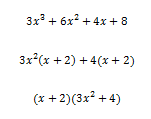It is the final week of classes so it is my turn to write
the blog post—unfortunately it will be the last post until January 2014. I will continue this blog the next time the
course is offered.
This is the first time that I have taught this course by
myself. Recently someone said that a
teacher should ask “what have they learned?” rather than “what have I
taught?” This class is definitely a good
class to ask the first question since I don’t think that I have really taught
my students anything. However, I am
fairly certain that they have learned lots of things. So, with their permission, here are their
answers to the question, “what have they learned in Math 371?”
From Leanne Holdorf:
Of all my classes this
semester, Math 371 is by far my favorite. I was able to dabble in technology
that I didn't think I'd have access to for a while. We explored different
programs and applications that will help me as a teacher. And I really started
to understand why technology is so important. It captivated me and made me
excited to learn more. That's what technology is meant to do in a classroom. It
is not simply there to make life a little easier but to also engage students in
new and different ways.
From Kaitlin Ward:
I have learned how to
use Ipads effectively in the classroom. I have learned what apps I might use in
my classroom, and what apps I know I won't use because I didn't find them very
useful. In addition, I have learned more about what different schools are going
one to one. I have learned how to create videos that I could use if I choose to
do flipped instruction. I have learned how to use programs like Voice Thread to
help make my lessons more engaging. Overall, I feel like I have a better grasp on
different programs and apps that I can use to help engage my students in the
classroom.
From Jackie Currier:
In math 371 I have learned how to use
different technology in ways that apply to the classroom. We learned how to use
a ti-nspire, using it in a classroom activity so all students can follow along,
how to connect it to the smart board, and how to export the calculator work and
print it to use in your class. We learned how to use an iPad mini in many
different classroom settings, from homework and class work management software
to in class activities we won't over dozens of different ways to use the iPads.
We also learned how to make an online survey, since you showed us making the
app rubric.
We also learned some probability and
statistics, since that is what content we used to make all these technological
activities. Though we may have skimmed the statistics part and stuck to the
probability part. However we became much more familiar with the standards for
probability and statistics for both middle school and high school.
From Dillon
Johnson:
I'm not sure if I can state exactly what I've
learned, but I do know that much of what I learned came from our
discussions. I think hearing other students’ perspectives on apps or
different technologies and their reasoning gave me my best learning as they
look at things much differently than I do.
So, what have I
learned as the instructor of the course?
I have learned:
·
Lacking
a detailed plan doesn’t mean that learning won’t occur.
·
Classroom
discussions are a meaningful instruction method.
·
It is
okay to get off topic once in a while.
·
Direct
instruction is my least favorite teaching technique.
·
My
students probably taught me more than I taught them.
This
class has been a lot of fun and I am already thinking of changes to make the
next time I teach it!
